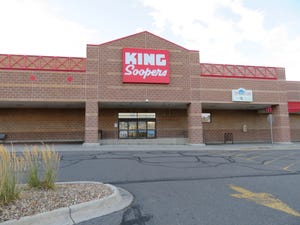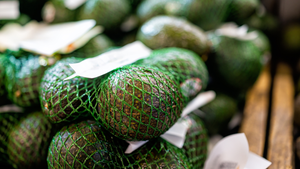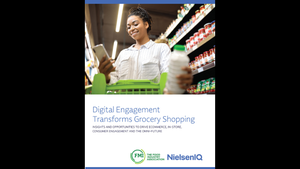Traceability: Improving Food Safety, Consumer ConfidenceTraceability: Improving Food Safety, Consumer Confidence
WHAT: Traceability: A Choice or a Necessity? WHEN: Friday, Oct. 12, 2:45-4 p.m. WHERE: Room 361ABC WHAT: The Revolution in Item-Level Coding WHEN: Saturday, Oct. 13, 9:35-10:50 a.m. WHERE: Room 361ABC Due to recent foodborne illness outbreaks traced back to produce, stronger food safety best practices have been a priority to buyers, sellers and consumers, but sources say another serious area of vulnerability
September 17, 2007
LIZ PARKS
WHAT: Traceability: A Choice or a Necessity?
WHEN: Friday, Oct. 12, 2:45-4 p.m.
WHERE: Room 361ABC
WHAT: The Revolution in Item-Level Coding
WHEN: Saturday, Oct. 13, 9:35-10:50 a.m.
WHERE: Room 361ABC
Due to recent foodborne illness outbreaks traced back to produce, stronger food safety best practices have been a priority to buyers, sellers and consumers, but sources say another serious area of vulnerability — the inability to trace cases and lots of conventional produce back to their point of origin — is still in desperate need of attention.
Until the traceability process is adequately addressed, informed sources say, growers, shippers and food retailers remain vulnerable to losing millions of dollars in sales revenue.
An estimated $19 million in retail spinach sales lost due to last fall's E. coli outbreak could have been significantly minimized if the produce supply chain had standard encoding systems in place to trace produce “one step back and one step forward” in accordance with the Bioterrorism Act of 2002, said Gary Fleming, vice president, industry technology and standards, for the Washington-based Produce Marketing Association, and moderator of the upcoming traceability workshop at PMA's Fresh Summit Show in Houston.
Such a tracing system has been in place in the organic foods industry for a long time, and may be one of the reasons why the organic foods industry and local farmers' markets are currently enjoying consistently strong growth.
Since August 1985, for example, PCC Natural Markets, an eight-unit natural food chain located in Seattle, has been labeling all the produce in its stores so people will know not just the country of origin, but also, in most cases, the farm of origin. Certified organic retailers were compliant with mandatory country-of-origin labeling before it became law when it was included in the 2002 Farm Bill.
“The whole point of the organic bookkeeping and paper trail is so we can have records on how the food was produced, from the source of seed, to the composting process, to when crop rotations were made,” said Trudy Bialic, director of public affairs for PCC.
In addition to giving U.S. consumers confidence in the quality and source of their purchased produce, certified organic retailers don't have to worry about the economic disruptions that a broad-scale recall can create.
“During the E. coli spinach outbreak last year, we were able to keep selling fresh bunch spinach, because we knew exactly where it was coming from,” said Bialic.
“We knew the farm, we knew the farmer and we knew it came from outside California. We called the U.S. Department of Agriculture and they told us as long as it wasn't from California, it wasn't a problem.”
But while the automated technology exists to enable a traceability system for conventional produce, a number of factors — including the challenges inherent in the process of implementing change and the necessity of investing in the infrastructure that supports such changes — have thus far kept traceability of conventional produce from becoming the industry norm.
PMA and the Canadian Produce Marketing Association, which worked together to establish the Best Practices Framework, recently conducted two surveys, in April and July 2007, that indicate how far the industry still has to go toward that goal.
According to the combined results of those surveys, just 2% of the 128 produce suppliers surveyed are currently shipping produce with standardized bar-code numbers that can be uniformly understood by members of the supply chain. And only 41% of the 58 retailers surveyed are actually reading produce bar codes when they do come into their supply chains.
Without the ability to read, store and share sourcing information, tracing a foodborne illness back to its source in a timely manner is extremely difficult, Fleming stressed.
To remedy that, and to create an effective produce traceability system as quickly as possible, the PMA is working with other trade associations, along with top retailers and many leading suppliers and growers of conventional produce, to form a task force to address the issue.
In addition, two large retailers, Bentonville, Ark.-based Wal-Mart and Loblaw in Toronto, are rolling out a new type of bar code called a GS1 DataBar.
Affixed to an individual piece of produce as part of a traditional Price Look-Up label, the GS1 DataBar can tell retailers where individual produce items come from, the type of produce it is, whether it is an organic vs. a conventional item, and more. The GS1 DataBar, similar to a Universal Product Code number on packaged goods, can be read by point-of-sale scanning systems made from 2002 on, and it can be used to eliminate the likelihood that cashiers will confuse organic produce with conventional produce, which will pay off for retailers at the cash register.
If a retailer has enabled or upgraded its point-of-sale systems to read the GS1 DataBar and has upgraded its information systems so it can capture the Global Trade Item Number, as Wal-Mart and Loblaw have done, it now has a record of where individual produce items came from. In the event of a foodborne illness outbreak, the retailer can also quickly trace infected products, bulk as well as packaged, back to the source, thereby protecting consumers and eliminating the expensive need to sweep everything off their shelves.
That same information can be captured on standardized GS1 bar codes that can be affixed to cases and pallets of variable-weight produce, such as crates of apples or oranges, as well as to fixed-weight produce. The information can then be read and scanned during delivery to a buyer's warehouse or distribution center.
“Even if a supplier is not putting a GS1 DataBar on loose individual produce items, they can still get a GS1 Company Prefix [a manufacturer identification number] and use that to create an ITF-14 or a GS1-128 bar code to encode their information on their cases and pallets,” said Greg Rowe, GS1 DataBar program manager.
To make the system work, however, sellers need to place a standardized GS1 bar code on their goods so buyers can read the GTIN as it comes into facilities and store that information for quick retrieval as needed. That is what is missing today, and what the industry leaders and their associations will be trying to remedy through the task force and through the adoption of standardized technologies like the GS1 DataBar and other GS1 bar codes.
Wal-Mart began testing the GS1 DataBar technology in stores serviced by its Grandview, Wash., distribution center in 2006, Wal-Mart spokeswoman Deisha Galberth told SN.
The technology can be found on produce such as Washington apples in these stores, she said, and Wal-Mart will use the test “to determine customer response before any plans to roll out the GS1 DataBar technology in our stores are made.”
However, a source familiar with the Wal-Mart test said the chain is already rolling out the GS1 DataBar to other produce categories, expanding the program to include bananas. It is now being implemented in approximately 50 stores.
Loblaw is taking a broader category approach and is having its suppliers put the GS1 DataBar on apples, bananas and avocados. Loblaw, which has the GS1 DataBar technology in about 30 stores, is currently reaching out and asking suppliers of tomatoes and peppers to do the same, said an informed source.
Other retailers, including Tesco in Europe, are testing the GS1 DataBar technology.
Currently, select produce suppliers for Wal-Mart and Loblaw are doing separate runs to apply the GS1 DataBar just for stores in the program, but the industry is working to streamline the technology to involve just one industry label. Wal-Mart, Loblaw and other retailers interested in using the GS1 DataBar technology are reaching out to the retail industry to move to one common PLU label containing both the GS1 DataBar and the PLU number, creating labeling efficiencies for suppliers, said Rowe.
“There are enough retailers and distributors interested in the technology that GS1 DataBar will eventually be implemented globally,” said Rowe. “Produce buyers and sellers see huge business benefits.”
According to a GS1 U.S. cost-benefit study, a 100-store retail chain utilizing GS1 DataBar labels can generate an annual operating savings of $2.32 million in produce and another $2.33 million in meats.
In addition, an average 100-store chain can generate an annual reduction in shrink dollars of more than $7.3 million from increased checkout accuracy.
Adoption of the GS1 DataBar may help to facilitate adoption of standardized bar codes for cases and pallets as well, Rowe noted.
Standardized bar codes, including the GS1 DataBar, have the ability to give the produce industry “a way to ensure that we can get contaminated products off the market quickly and efficiently,” said John Rushing, food science professor and food science extension specialist leader, North Carolina State University, Raleigh, and consultant, Institute of Food Technologists, Chicago.
“We need that, because right now the pressure is on from consumers demanding better safeguards when it comes to foods, medicines, even toys. We get a lot of phone calls from people asking for country-of-origin information, saying things like, ‘I want to buy things that aren't made in China,’ and they can't understand why you can't always give them an answer about where foods are grown.”
Rushing says he believes that because of the growing pressure from consumers and the obvious need for change, an effective process for produce traceability may be in place in a year or two.
“You're going to see companies like Wal-Mart saying, ‘We are not going to buy produce without traceability,’ and that means everybody will have to put in that technology,” he said.
“We're going to reach a point where only the companies that have traceability will sell things.”
There are other incentives that seem to be bringing produce traceability closer to a working reality.
Wal-Mart and Loblaw have found that they can save “a ton of money by ensuring that cashiers can now ring up bulk produce items accurately,” said Fleming. “Cashiers now have a way to tell the difference between conventional produce and the more expensive organic produce.”
| Retailers | % of stores that have GS1 DataBar capable scanners in 2007 | % of stores that will have GS1 DataBar capable scanners by 2010 |
|---|---|---|
| Ahold USA | 95 | 100 |
| Carrefour | 80 | 98 |
| DLM | 100 | 100 |
| Karstadt | 100 | 100 |
| Loblaw | 80 | 100 |
| Metro | 100 | 100 |
| Seiyu | 100 | 100 |
| Target | 88 | 100 |
| Uny | 0 | 87 |
| Wal-Mart | 100 | 100 |
| Wegmans | 100 | 100 |
| Woolworths | 75 | 100 |
| Source: GS1US Barcodes & Identification Report | ||
About the Author
You May Also Like




